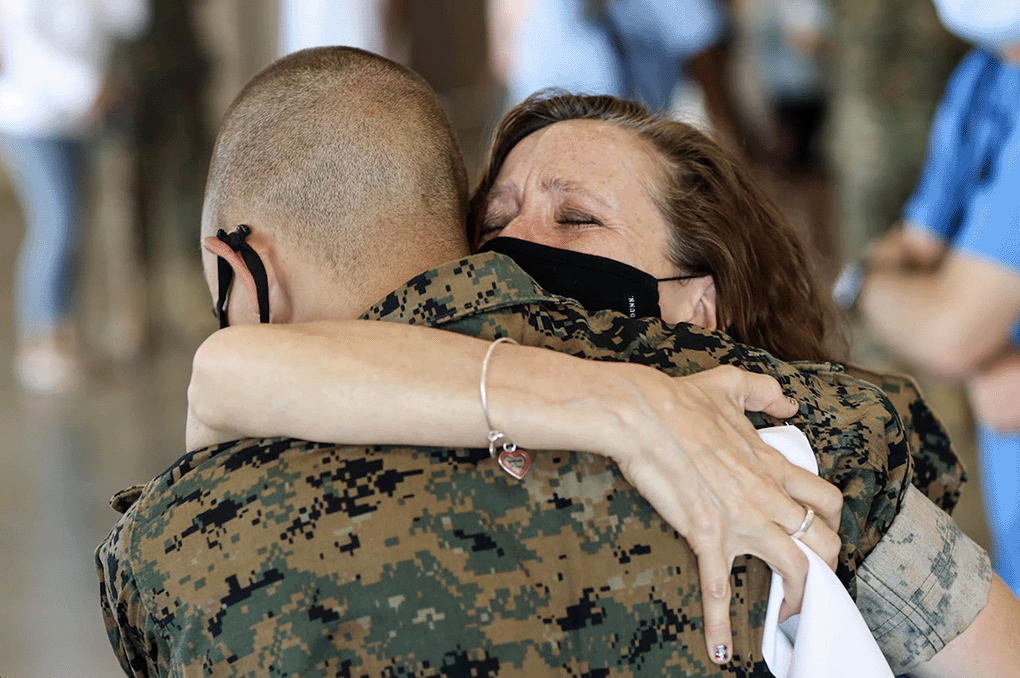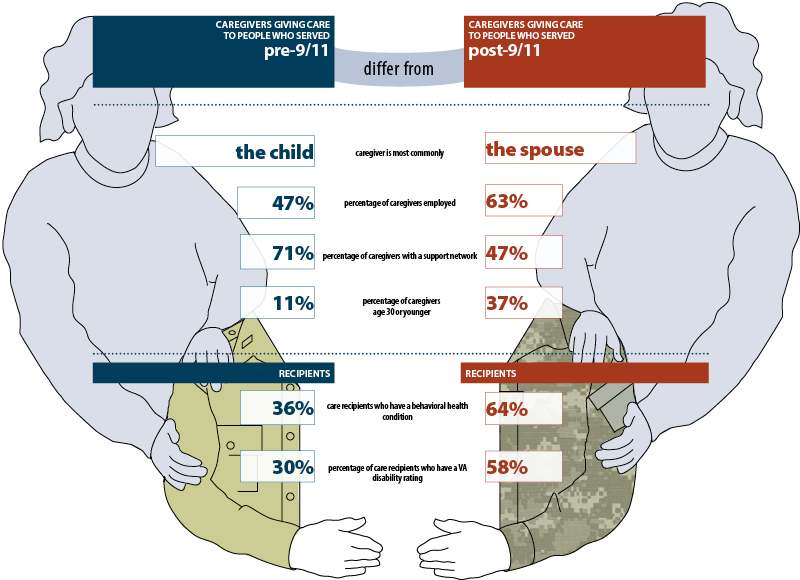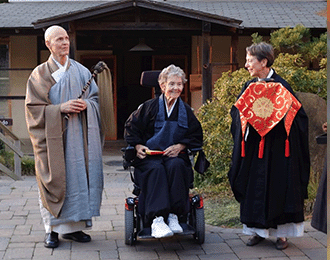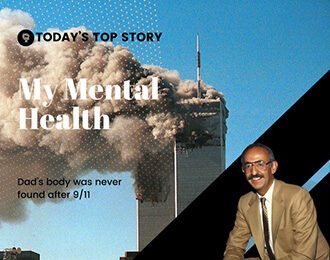Military Caregivers: Who are They? And Who Is Supporting Them?

RAND Corporation Updated for June 2021
There are 5.5 million Americans caring for ill or wounded service members and veterans.
More than 2.5 million U.S. service members have been deployed to Afghanistan and Iraq since 2001. Their wartime experiences have led to a sharp increase in the number of veterans living with disabilities. Many veterans of these and earlier conflicts rely for their day-to-day needs on care provided by family or friends. These informal caregivers, whom we term military caregivers, provide a range of indispensable services, saving the nation millions of dollars in health and long-term care costs.
RAND researchers estimate that there are 5.5 million military caregivers in the United States today. To improve the nation’s understanding of this little-studied group and the programs and services available to them, we set out to describe who these caregivers are, the burden of care that they bear, their support needs, the constellation of programs and other resources that exist to support them, and areas where additional support is needed.
Research on military caregivers is scant; to better understand their characteristics and needs, RAND fielded the only nationally representative survey of military caregivers to date, as well as companion surveys of civilian caregivers and non-caregivers. In addition, we conducted a comprehensive review of programs and support resources available to address the many needs of military caregivers.
Biggest Gaps in Support
Among the specialty areas covered by the 127 programs nationwide supporting military caregivers, these are covered by the fewest programs:
10% provide Mental health care
- Mental health care offered outside of normal institutional channels
7% provide Respite care
- Care provided by a substitute to give caregiver a break
3% provide Health care
- Care offered outside of normal institutional channels
3% provide religious support
- Religious or spiritual guidance/counseling
2% provide financial stipend
- Compensation for caregiver’s time
Post-9/11 Military Caregivers Differ from Other Caregivers
Of the 5.5 million military caregivers in the United States, 1.1 million (20 percent) are caring for veterans and service members who served after September 11, 2001. These post-9/11 caregivers differ dramatically from military caregivers helping veterans from earlier eras, who tend to more closely resemble civilian caregivers.
For example, among civilian and pre-9/11 military caregivers, children caring for their parents comprise the largest share (37 percent) of caregivers, while the largest share of post-9/11 caregivers are spouses (33 percent), many of whom are also raising children; in addition, a quarter are friends of the care recipient.

Post-9/11 caregivers differ in other ways as well. As shown in the figure, they are younger, caring for a service member or veteran with a behavioral health condition. This profile bears directly on the tasks post-9/11 caregivers perform. Because they care for younger individuals who often have behavioral health issues, many more help their care recipient cope with emotional and behavioral challenges, unlike pre-9/11 caregivers, who spend more time performing traditional caregiving duties, such as assisting with functional tasks of daily living. And they often must perform these caregiving duties alone—more than half of post-9/11 military caregivers lack a network that helps with caregiving duties, whereas 71 percent of pre-9/11 caregivers have such a network.
Moreover, caregiving duties take time. Nearly 20 percent of post-9/11 caregivers spend more than 40 hours per week performing caregiving duties, and collectively the value they provide society is worth at least $3 billion.
Most Relevant Programs and Policies Serve Caregivers Only Incidentally
More than 100 programs offer direct services to military caregivers. However, few are designed specifically for the caregiver population. Many target wounded, ill, or injured service members and veterans—and extend services to family caregivers—or they target military or veteran families, some of whom may be caregivers. Other programs are often not as relevant to post-9/11 caregivers because they are geared toward caregivers for older populations—more than 80 percent of post-9/11 caregivers are caring for someone under age 60.
More than 100 programs offer direct services to military caregivers. However, few are designed specifically for the caregiver population. Many target wounded, ill, or injured service members and veterans—and extend services to family caregivers—or they target military or veteran families, some of whom may be caregivers. Other programs are often not as relevant to post-9/11 caregivers because they are geared toward caregivers for older populations—more than 80 percent of post-9/11 caregivers are caring for someone under age 60.
We also found gaps in service offerings. The box on the previous page describes the types of services we identified and the numbers of programs offering them. The array of programs is tilted toward direct assistance (“helping hand”) and social service programs—more than 50 of each, while fewer than 10 programs offer assistance in other key areas, such as respite care, financial support, and health care.
Recommendations
- Policymakers should advance these strategies to support military caregivers:
- Provide high-quality education and training to help military caregivers understand their roles and to teach them necessary skills.
- Help caregivers get health care coverage and use existing structured social support.
- Increase public awareness of the role, value, and consequences of military caregiving.
- Promote work environments that support caregivers, protect them from discrimination and promote workplace adaptations.
- Incorporate caregivers as part of the health care team in all health care environments catering to military and veteran recipients.
- Ensure that caregivers are supported based on the tasks and duties they perform, rather than their relationship to the care recipient.
- Make respite care more widely available to military caregivers, including alternative respite care strategies.
- Encourage caregivers to create financial and legal plans to ensure caregiving continuity for care recipients.
- Enable sustainability of programs by integrating and coordinating services across sectors and organizations through formal partnership arrangements.
- Foster caregiver health and well-being through access to high-quality services.
- Invest in research to document the evolving need for caregiving assistance among veterans and the long-term impact of caregiving on the caregivers.
Caregiving Imposes a Heavy Burden
Caring for a loved one is a demanding task. Military caregivers consistently experience worse health, greater strains in family relationships, and more workplace problems than non-caregivers, and it is worst for post-9/11 caregivers. Military caregivers also face an elevated risk for depression; caregivers who spend more time caregiving and those who help care recipients cope with behavioral problems are most likely to exhibit symptoms of depression.
What’s more, 33 percent of post-9/11 military caregivers lack health care coverage. Caregiving can also pose a financial burden to caregivers, employers, and society. Forty-seven percent of post-9/11 caregivers report needing to adjust their work schedules as a result of caregiving, and 62 percent reported that caregiving caused them financial strain. Military caregiving to post-9/11 veterans and service members costs the U.S. economy about $5.9 billion annually in caregivers’ lost productivity from work.
The Future of Caregiving Support Is Uncertain
Three factors make the future of caregiving support uncertain, particularly for post-9/11 service members and veterans:
- 25 percent rely on their parents who are aging and who, starting in 15 years, will no longer be able to provide caregiving support
- 33 percent rely on spouses; these relationships are young, and as many as one-third of these marriages may dissolve
- More than half of support programs for caregivers were established in the past ten years, and 80 percent are nonprofit. They are vulnerable to waning public interest, lowered philanthropic support, and shortfalls in capacity to deliver services effectively
The Bottom Line
Pre-9/11 caregivers resemble civilian caregivers:
They are typically older adults caring for an aging parent or a spouse caring for an aging partner.
By contrast, post-9/11 military caregivers present a different profile. They are younger, more likely to be the spouse or friend of the care recipient, perform different caregiving duties, and are more likely to juggle work and caregiving commitments.
All military caregivers face elevated risks of poor health outcomes, strained family relationships, and financial losses from missed work; these risks are higher among post-9/11 military caregivers.
Programs to support military caregivers often do so incidentally by extending services for service members and veterans to family caregivers or by including caregivers in services provided for military families. Few services are designed specifically for military caregivers, and some caregivers are excluded from services that might benefit them.
Few caregiver support programs provide respite care, health care coverage, and financial support to offset income loss, though these may be the areas of greatest need.
Caregiver needs will change over time due to age and changes in relationships, requiring planning for future contingencies.
For additional resources and information visit rand.org
Authors:
Rajeev Ramchand, Terri Tanielian, Michael P. Fisher, Christine Anne Vaughan, Thomas E. Trail, Caroline Batka, Phoenix Voorhies, Michael W. Robbins, Eric Robinson, Bonnie Ghosh-Dastidar





